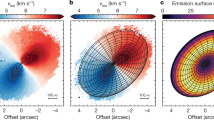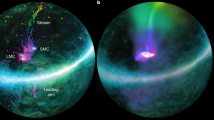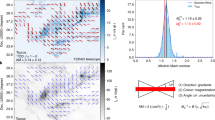Abstract
Observations indicate that molecular clouds are strongly magnetized, and that magnetic fields influence the formation of stars. A key observation supporting the conclusion that molecular clouds are significantly magnetized is that the orientation of their internal structure is closely related to that of the magnetic field. At low column densities, the structure aligns parallel with the field, whereas at higher column densities, the gas structure is typically oriented perpendicular to magnetic fields, with a transition at visual extinctions AV ≳ 3 mag. Here we use far-infrared polarimetric observations from the HAWC+ polarimeter on SOFIA to report the discovery of a further transition in relative orientation, that is, a return to parallel alignment at AV ≳ 21 mag in parts of the Serpens South cloud. This transition appears to be caused by gas flow and indicates that magnetic supercriticality sets in near AV ≳ 21 mag, allowing gravitational collapse and star cluster formation to occur even in the presence of relatively strong magnetic fields.
This is a preview of subscription content, access via your institution
Access options
Access Nature and 54 other Nature Portfolio journals
Get Nature+, our best-value online-access subscription
$29.99 / 30 days
cancel any time
Subscribe to this journal
Receive 12 digital issues and online access to articles
$119.00 per year
only $9.92 per issue
Buy this article
- Purchase on Springer Link
- Instant access to full article PDF
Prices may be subject to local taxes which are calculated during checkout




Similar content being viewed by others
Data availability
The HAWC+ data that support the plots within this paper and other findings of this study are available from the SOFIA data archive at https://dcs.arc.nasa.gov/dataRetrieval/SearchScienceArchiveInfo.jsp under project code 05_0206 or from the corresponding author upon reasonable request.
Code availability
The source code for POLARIS and PolarisTools used in this paper and written by S.R. are publicly available at http://www1.astrophysik.uni-kiel.de/polaris/.
References
Crutcher, R. M. Magnetic fields in molecular clouds. Annu. Rev. Astron. Astrophys. 50, 29–63 (2012).
Li, H.-B. et al. in Protostars and Planets VI (eds Beuther, H. et al.) 101–123 (Univ. Arizona Press, 2014).
Planck Collaboration et al. Planck intermediate results. XXXV. Probing the role of the magnetic field in the formation of structure in molecular clouds. Astron. Astrophys. 586, A138 (2016).
Soler, J. D. et al. The relation between the column density structures and the magnetic field orientation in the Vela C molecular complex. Astron. Astrophys. 603, A64 (2017).
Sugitani, K. et al. Near-infrared-imaging polarimetry toward Serpens South: revealing the importance of the magnetic field. Astrophys. J. 734, 63 (2011).
Palmeirim, P. et al. Herschel view of the Taurus B211/3 filament and striations: evidence of filamentary growth? Astron. Astrophys. 550, A38 (2013).
Franco, G. A. P. & Alves, F. O. Tracing the magnetic field morphology of the Lupus I molecular cloud. Astrophys. J. 807, 5 (2015).
Santos, F. P., Busquet, G., Franco, G. A. P., Girart, J. M. & Zhang, Q. Magnetically dominated parallel interstellar filaments in the infrared dark cloud G14.225-0.506. Astrophys. J. 832, 186 (2016).
Soler, J. D. Using Herschel and Planck observations to delineate the role of magnetic fields in molecular cloud structure. Astron. Astrophys. 629, A96 (2019).
Gutermuth, R. A. et al. The Spitzer Gould Belt Survey of large nearby interstellar clouds: discovery of a dense embedded cluster in the Serpens-Aquila Rift. Astrophys. J. Lett. 673, L151–L154 (2008).
Ortiz-León, G. N. et al. Gaia-DR2 confirms VLBA parallaxes in Ophiuchus, Serpens, and Aquila. Astrophys. J. Lett. 869, L33 (2018).
Myers, P. C. Filamentary structure of star-forming complexes. Astrophys. J. 700, 1609–1625 (2009).
Lazarian, A. & Hoang, T. Radiative torques: analytical model and basic properties. Mon. Not. R. Astron. Soc. 378, 910–946 (2007).
Andersson, B.-G., Lazarian, A. & Vaillancourt, J. E. Interstellar dust grain alignment. Annu. Rev. Astron. Astrophys. 53, 501–539 (2015).
Kusune, T. et al. Magnetic field structure in Serpens South. Publ. Astron. Soc. Jpn 17, S5 (2019).
André, P. et al. From filamentary clouds to prestellar cores to the stellar IMF: initial highlights from the Herschel Gould Belt Survey. Astron. Astrophys. 518, L102 (2010).
Könyves, V. et al. A census of dense cores in the Aquila cloud complex: SPIRE/PACS observations from the Herschel Gould Belt Survey. Astron. Astrophys. 584, A91 (2015).
Kauffmann, J., Bertoldi, F., Bourke, T. L., Evans, N. J. I. I. & Lee, C. W. MAMBO mapping of Spitzer c2d small clouds and cores. Astron. Astrophys. 487, 993–1017 (2008).
Clark, S. E., Peek, J. E. G. & Putman, M. E. Magnetically aligned H I fibers and the Rolling Hough Transform. Astrophys. J. 789, 82 (2014).
Körtgen, B. & Banerjee, R. Impact of magnetic fields on molecular cloud formation and evolution. Mon. Not. R. Astron. Soc. 451, 3340–3353 (2015).
Gómez, G. C., Vázquez-Semadeni, E. & Zamora-Avilés, M. The magnetic field structure in molecular cloud filaments. Mon. Not. R. Astron. Soc. 480, 2939–2944 (2018).
Li, P. S., Klein, R. I. & McKee, C. F. Formation of stellar clusters in magnetized, filamentary infrared dark clouds. Mon. Not. R. Astron. Soc. 473, 4220–4241 (2018).
Sadavoy, S. I. et al. Dust polarization toward embedded protostars in Ophiuchus with ALMA. II. IRAS 16293-2422. Astrophys. J. 869, 115 (2018).
Maury, A. J. et al. Magnetically regulated collapse in the B335 protostar? I. ALMA observations of the polarized dust emission. Mon. Not. R. Astron. Soc. 477, 2760–2765 (2018).
Takahashi, S. et al. ALMA high angular resolution polarization study: an extremely young class 0 source, OMC-3/MMS 6. Astrophys. J. 872, 70 (2019).
Le Gouellec, V. J. M. et al. Characterizing magnetic field morphologies in three Serpens protostellar cores with ALMA. Astrophys. J. 885, 106 (2019).
Kirk, H. et al. Filamentary accretion flows in the embedded Serpens South protocluster. Astrophys. J. 766, 115 (2013).
Fernández-López, M. et al. CARMA Large Area Star Formation Survey: observational analysis of filaments in the Serpens South molecular cloud. Astrophys. J. Lett. 790, L19 (2014).
Monsch, K. et al. Dense gas kinematics and a narrow filament in the Orion A OMC1 region using NH3. Astrophys. J. 861, 77 (2018).
Liu, T. et al. A holistic perspective on the dynamics of G035.39-00.33: the interplay between gas and magnetic fields. Astrophys. J. 859, 151 (2018).
McKee, C. F. & Ostriker, E. C. Theory of star formation. Annu. Rev. Astron. Astrophys. 45, 565–687 (2007).
Pillai, T. et al. Magnetic fields in high-mass infrared dark clouds. Astrophys. J. 799, 74 (2015).
Mestel, L. The magnetic field of a contracting gas cloud. I. Strict flux-freezing. Mon. Not. R. Astron. Soc. 133, 265–284 (1966).
Myers, P. C., Basu, S. & Auddy, S. Magnetic field structure in spheroidal star-forming clouds. Astrophys. J. 868, 51 (2018).
Hill, T. et al. Resolving the Vela C ridge with P-ArTéMiS and Herschel. Astron. Astrophys. 548, L6 (2012).
Montier, L. et al. Polarization measurement analysis. II. Best estimators of polarization fraction and angle. Astron. Astrophys. 574, A136 (2015).
Pattle, K. et al. JCMT BISTRO Survey observations of the Ophiuchus molecular cloud: dust grain alignment properties inferred using a Ricean noise model. Astrophys. J. 880, 27 (2019).
Alves, F. O. et al. On the radiation driven alignment of dust grains: detection of the polarization hole in a starless core (corrigendum). Astron. Astrophys. 574, C4 (2015).
Kandori, R. et al. Distortion of magnetic fields in a starless core. V. Near-infrared and submillimeter polarization in FeSt 1-457. Astrophys. J. 868, 94 (2018).
Reissl, S., Wolf, S. & Brauer, R. Radiative transfer with POLARIS. I. Analysis of magnetic fields through synthetic dust continuum polarization measurements. Astron. Astrophys. 593, A87 (2016).
Schneider, N. et al. Dynamic star formation in the massive DR21 filament. Astron. Astrophys. 520, A49+ (2010).
Peretto, N. et al. Global collapse of molecular clouds as a formation mechanism for the most massive stars. Astron. Astrophys. 555, A112 (2013).
Vaillancourt, J. E. et al. Far-infrared polarimetry from the Stratospheric Observatory for Infrared Astronomy. In Proc. SPIE, Vol. 6678, Infrared Spaceborne Remote Sensing and Instrumentation (ed Strojnik-Scholl, M.) 66780D (SPIE 2007).
Dowell, C. D. et al. HAWCPol: a first-generation far-infrared polarimeter for SOFIA. In Society of Photo-Optical Instrumentation Engineers (SPIE) Conference Series Vol. 7735, 77356H (SPIE, 2010).
Harper, D. A. et al. HAWC+, the far-infrared camera and polarimeter for SOFIA. J. Astron. Instrum. 7, 1840008 (2018).
Gordon, M. S. et al. SOFIA Community Science I: HAWC+ polarimetry of 30 Doradus. Preprint at http://arXiv.org/abs/1811.03100 (2018).
Serkowski, K. in Methods in Experimental Physics Vol. 12 (ed Carleton, N.) 361–414 (Academic Press, 1974).
Clemens, D. P. et al. Magnetic field uniformity across the GF 9-2 YSO, L1082C dense core, and GF 9 filamentary dark cloud. Astrophys. J. 867, 79 (2018).
Myers, P. C. Star-forming filament models. Astrophys. J. 838, 10 (2017).
Plummer, H. C. On the problem of distribution in globular star clusters. Mon. Not. R. Astron. Soc. 71, 460–470 (1911).
Friesen, R. K., Bourke, T. L., Di Francesco, J., Gutermuth, R. & Myers, P. C. The fragmentation and stability of hierarchical structure in Serpens South. Astrophys. J. 833, 204 (2016).
Reissl, S., Seifried, D., Wolf, S., Banerjee, R. & Klessen, R. S. The origin of dust polarization in molecular outflows. Astron. Astrophys. 603, A71 (2017).
Martin, P. G. & Whittet, D. C. B. Interstellar extinction and polarization in the infrared. Astrophys. J. 357, 113 (1990).
Mathis, J. S., Mezger, P. G. & Panagia, N. Interstellar radiation field and dust temperatures in the diffuse interstellar matter and in giant molecular clouds. Astron. Astrophys. 500, 259–276 (1983).
Dunham, M. M. et al. Young stellar objects in the Gould Belt. Astrophys. J. Suppl. Ser. 220, 11 (2015).
Acknowledgements
Based in part on observations made with the NASA/DLR Stratospheric Observatory for Infrared Astronomy (SOFIA). SOFIA is jointly operated by the Universities Space Research Association, Inc. (USRA), under NASA contract NAS2-97001, and the Deutsches SOFIA Institut (DSI) under DLR contract 50 OK 0901 to the University of Stuttgart. Financial support for this work was provided to T.P. by DLR through award number 50 OR 1719. D. Dowell, the SOFIA HAWC+ team, the SOFIA flight and ground crews, and the USRA SOFIA Project teams developed the SOFIA observatory, the HAWC+ instrument, performed the airborne observations, processed and calibrated the data, and delivered science-ready data products. D.P.C. acknowledges support funder NSF AST 18-14531, USRA SOF_4-0026 and NASA NNX15AE51G. D.S. acknowledges the support of the Bonn-Cologne Graduate School, which is funded through the German Excellence Initiative and funding by the Deutsche Forschungsgemeinschaft (DFG) via the Collaborative Research Center SFB 956 Conditions and Impact of Star Formation (subprojects C5 and C6). G.A.P.F. is partially supported by CNPq and FAPEMIG. This research has made use of data from the Herschel Gould Belt survey (HGBS) project (http://gouldbelt-herschel.cea.fr and ref. 16).
Author information
Authors and Affiliations
Contributions
T.P. led the SOFIA proposal, data analysis, interpretation of the data and the paper writing. The other authors contributed to the writing of the manuscript. D.P.C., S.R., P.C.M. and J.K. participated in the data analysis. E.L.-R. led the SOFIA data reduction. F.O.A. and G.A.P.F. conducted near-infrared polarization observations. K.S. provided the published near-infrared polarization data used in this study. J.H., K.M.M., F.N., D.S. and H.W. provided expertise in molecular cloud studies.
Corresponding author
Ethics declarations
Competing interests
The authors declare no competing interests.
Additional information
Publisher’s note Springer Nature remains neutral with regard to jurisdictional claims in published maps and institutional affiliations.
Rights and permissions
About this article
Cite this article
Pillai, T.G., Clemens, D.P., Reissl, S. et al. Magnetized filamentary gas flows feeding the young embedded cluster in Serpens South. Nat Astron 4, 1195–1201 (2020). https://doi.org/10.1038/s41550-020-1172-6
Received:
Accepted:
Published:
Issue Date:
DOI: https://doi.org/10.1038/s41550-020-1172-6
This article is cited by
-
Magnetic fields going with the flow
Nature Astronomy (2020)



